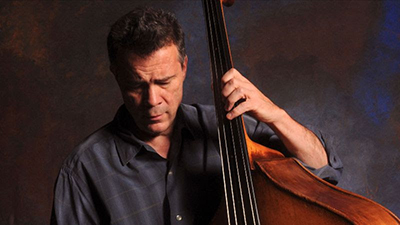by Mike Telin

Alone onstage with his bass, looking out into a socially distanced crowd of around 300, Meyer presented a mesmerizing 70-minute recital that featured music from the Baroque to bluegrass. Playing with the precision of a champion figure skater, Meyer’s fingers glided from one end of the instrument’s fingerboard to the other, flawlessly negotiating the tightest of turns — the guy has technique to spare — and sticking the landing of each musical leap, his intonation pitch-perfect. Above all, his artistry was beyond reproach.
Without fuss the bassist launched into Bach’s First Cello Suite. Highlighted by smooth, lyrical playing, the opening Prelude was pure listening pleasure. The Allemande showcased his nimble dexterity — the lines all had purposeful direction. The Courante was a display of technical mastery, the Sarabande, lovely. Minuet I was defined by crisp articulations and subtle changes during repeated sections. In Minuet II he brought a change of character, taking time in all the right places. And in the concluding Gigue, Meyer let the instrument sing in full-voice as he tossed off the technical passages with flair.
A natural comedic straight man, Meyer told the audience that the first movement of his Work in Progress “starts slow, gets fast, then slow again.” He went on to demonstrate the use of the C extension in the middle movement, and said that the third is based on four groups of sequences. “Now you know just about as much as I do.”
Indeed, the piece begins slowly with scale passages maneuvering at both ends of the register. A jazzy ostinato, jaunty accents, and low growls lead to some full-throttled fiddling. Lively pizzicatos, alternating between clear and twangy, open “II.” Here, Meyer takes the listener on a roller coaster ride from the lowest register to the highest and back down again while providing plenty of changes in dynamics. In “III” the initial statements and redistribution of the four groups of sequences ultimately result in whirlwinds of sound into the instrument’s stratosphere, then a plunge into a long, low rumble.
The piece is enjoyable and shows off all that can be done on the bass, in the right hands. It also made a nice complement to the Bach.
The final section of the program featured music by Meyer’s friend and frequent collaborator Béla Fleck, as well as a tribute to bassist Ray Brown.
But it was the pairing of tunes by Jobim/Gilberto and Arty McGlynn that brought the evening to a rousing conclusion. How Meyer was able to make a smooth transition from a samba into a jig is a mystery — but what a jig. Think bass strings on fire.
Published on ClevelandClassical.com April 28, 2021.
Click here for a printable copy of this article



